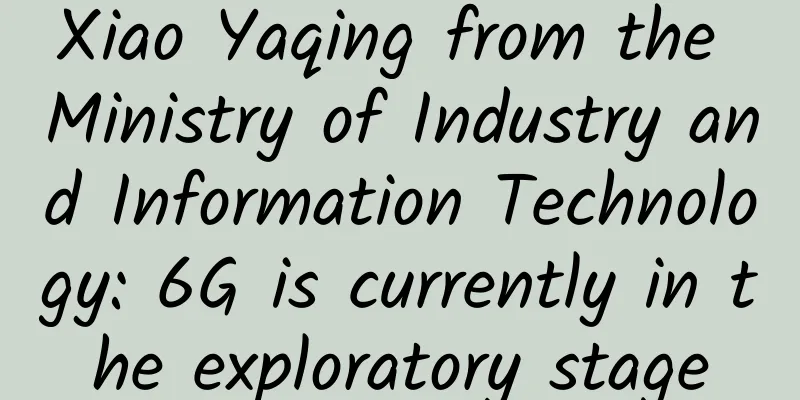The battle of 1G to 5G, the communication reshuffle is about to begin

|
Recently, there has been a big conflict between Huawei and the US government, but in the final analysis, 5G is unavoidable. Where there are people, there are rivers and lakes. The communications world is full of intrigues and deceptions. From analog signals to digital signals, from 1G, 2G, 3G, 4G to the now popular 5G, if you stand on the right side, you will be promoted quickly, but if you stand on the wrong side, you will be "doomed". You finish singing, I will come on stage 1978 was an interesting year. The event that reversed China's economic development happened in this year. The milestone invention that changed the traditional communication system also took place in 1978. At that time, Bell Labs developed an advanced mobile phone system using analog signals and frequency division multiple access technology, and the 1G era began. At this time, Motorola was the leader. From pagers to "big brother" phones, Motorola could be said to be the absolute king in the field of mobile communications, and its competitors were even rarer.
At that time, the global communications industry was still in a situation of "one superpower and many strong countries". Motorola, which monopolized 1G, also allowed the United States to successfully control the first generation of communications standards. European countries were independent of each other, and the various communications standards and formats were dazzling. As a technology that has been transferred from the military to the civilian sector, the development of communications is often a struggle between countries. On the one hand, the disadvantaged party needs to continue to pay high patent fees to the other alliance, and on the other hand, the other party will take the initiative in the industry. Unfortunately, in the early communications battlefield, China had little say, but the United States and the European Union had several close battles over digital communications standards. In the 2G era, European countries worked together to develop GSM, which was based on time division multiple access (TDMA), and quickly spread to the world. In 1995, my country also began to build a GSM global communication network. In this round, Motorola fell from the altar, and even a strong country like the United States failed to wake up from the dream of 1G.
The chain reaction of the rise of the European mobile communications industry was the rapid expansion of local communications companies. Nokia and Ericsson were the biggest beneficiaries, and both quickly became the world's leading communications equipment and mobile phone manufacturers. In 1993, Ericsson accounted for 60% of the global digital cellular equipment market, and Nokia became the world's second largest mobile phone supplier. However, Qualcomm's intervention completely disrupted the gradually stable layout of the communications industry. The "dark horse" Qualcomm quickly proved the feasibility and advantages of CDMA commercialization with its technical strength by winning over Korean operators. At that time, the global communications technology was preparing to transition from 2G to 3G. During this period, the domestic communications market also underwent tremendous changes and turbulence. After a series of dazzling adjustments, the competition pattern among the seven major telecom operators in China (China Telecom, China Mobile, China Unicom, China Satellite Communications, China Small Network Communications, China Jitong, and China Railway Communications) was basically formed. In early 2002, China Unicom's CDMA network was officially launched, and my country entered a new stage of mutual competition and common development between GSM and CDMA. It was also from 3G that more and more roles appeared on the communications industry stage, including operators, equipment manufacturers, terminal manufacturers and even chip manufacturers. Everything began to move in a new direction. It is just like you finish your performance and I come on stage. Every iteration of communication technology is not only a game between countries, but also an opportunity for an industry, because its changes will bring considerable economic effects to the industrial chain. The battle for communication standards: a major reshuffle When Motorola's beautiful phone number was auctioned for hundreds of thousands of dollars, it never thought that it would be overshadowed by Nokia years later, and Nokia also failed to anticipate that the wave of Apple's creation would cause them to completely lose the mobile terminal market. When a mantis stalks a cicada, there is always an oriole behind it. The characteristics of the early communications industry determined the dual identity of mobile phone manufacturers. Nokia and Motorola were both telecom equipment manufacturers and mobile phone manufacturers. They were both the makers of rules and the beneficiaries of the rules. The emergence of HTC and Apple changed this situation. The emergence of smartphones has made communication operators talk about 3G, which has been useless for nearly a decade, and has finally found the most suitable business scenario. The main difference between 3G and 2G is that 3G supports high-speed data transmission, such as pictures, videos, audio, etc.
In the 3G era, TD-SCDMA submitted by my country officially became an international standard, and became one of the three most mainstream technologies in the 3G era along with WCDMA in Europe and CD-MA2000 in the United States. At this time, a tripartite situation was formed. Qualcomm and Apple, who were inseparable at the time, joined forces to sweep the global mobile terminal market. However, the storm is coming. During the transition period from 3G to 4G, the close partners of the past stood on opposite sides. The reshuffle was accompanied by a new round of team-up. In this process, telecom equipment vendors such as Nortel that stood on the wrong side were "washed out". In order to circumvent Qualcomm's high patent licensing fees, Chinese and European communication operators united to create LTE based on OFDM technology. At the same time, Intel, IBM, Nortel, and Motorola in North America focused on the WiMax standard. Qualcomm made a desperate move and launched a plan called UMB for CDMA technology, but it eventually declined due to too few supporters. WiMax, led by Intel, needed to build base stations from scratch and was not technically mature enough. Compared with LTE, few operators bought it. In the end, tens of billions of dollars were wasted, and Canadian Nortel, which sold its traditional 3G business and switched to WIMAX, went bankrupt.
In the early days, the world's mainstream communications equipment vendors included Ericsson, Nokia, Siemens, Alcatel, Lucent, Nortel, Motorola, Huawei, and ZTE. During the 1G to 2G iteration, Motorola failed to keep up with the pace of transformation and fell behind. From 3G to 4G, Nortel declared bankruptcy, and Alcatel and Lucent merged. Later, Siemens, Motorola, and Alcatel-Lucent were also merged into Nokia. After restructuring, acquisitions, mergers and other adjustments, the global communications equipment vendors finally formed a four-way competition among Huawei, Ericsson, Nokia and ZTE. The new group members have taken action. Communication industry observer Tie Liu once commented: In the 4G era, to put it nicely, developing two communication standards is to achieve double insurance. To put it bluntly, it means repeated research and development, scattered forces, and each fighting for its own, failing to form a joint force, and there is a risk of being defeated one by one. The lesson learned is that if you suffer too much loss, cooperation will make things easier, and the other side of cooperation is to take sides. In the 4G era, the telecom equipment manufacturers were the ones who were eliminated by the waves. Gradually, a multi-legged situation of mobile phone manufacturers was initially formed. From the early scattered chaos to the current centralized team, those who are left have to face the choice of the 5G era. However, the direction of the 5G battlefield has changed again. 5G division: the battle between baseband chips and operators The transition to 3G took about 10 years, and the emergence of smartphones has made the third-generation communication technology clear. Similarly, the fifth-generation communication technology is also facing similar problems. 5G defines three major scenarios: enhanced mobile broadband (eMBB), massive machine type communications (mMTC), and ultra-reliable low-latency communications (uRLLC). These three scenarios represent three "forms" of the network. eMBB is for people to connect to the Internet, while uRLLC and mMTC are for the Internet of Things.
In any of the three scenarios, none of them constitutes a rigid demand at present. However, eMBB is the fastest-growing one at present. From the perspective of technical standards, the standard for eMBB is R15, which is divided into three stages. The R15 NR NSA (new air interface non-independent networking) standard was completed in December 2017, and the R15 NR SA (new air interface independent networking) standard was completed in June 2018. The 5G Late Drop standard has been postponed. However, this time, there is no standard divergence in communication standards as in previous generations of communication technology. In the iteration process of previous generations of communication technology, the competition and cooperation pattern in the upstream has been established, while the chip factories and terminal factories in the downstream are undercurrents. In the 5G era, there are countless cases of cooperation, but there are also many conflicts. In an article on Magnetron.com titled "It may be too early to talk about the 'storm' of 5G, the tug-of-war between chip manufacturers is just the warm-up for this change", the competition among chip manufacturers over 5G baseband was mentioned. In this war, the friction formed during the development of the previous generation of communication technology naturally affected the cooperation in the 5G era. For example, due to policy sensitivity, Intel and Tsinghua Unigroup’s 5G cooperation fell through and they parted ways. Due to interest issues, Apple and Qualcomm are irreconcilable. Under 5G, whether Apple will stand in the camp of MediaTek or Intel, or be self-sufficient, is still unknown. Above the baseband, the 5G battle among mobile terminal manufacturers is on the rise. From the hype last year to the concentrated releases at MWC, 5G mobile phones are becoming a new battlefield. Unlike previous generations of communication technologies, the leading role this time has been taken by terminal manufacturers. On the other hand, behind each generation of communication system changes, there is a bloody battle among operators, who compete for frequency band resources, 5G base stations, demonstration scenarios, and try their best to attract terminal manufacturers. No one dares to fall behind. They race against time and traffic. Even if there is no large-scale commercial use, they must show their swords first and make every effort to attract enough attention on the eve of commercial use.
The communications industry has been developing for decades, and there is no absolute winner. The ups and downs seem to follow a pattern. The leader in the 4G era may not be able to catch up with 5G. The arrival of 5G will inevitably lead to a new round of disputes in the communications industry. Some references for this article:
|
>>: Science article! What is 5G?
Recommend
Mobile phone signal enhancement stickers are hot-selling, experts: The principle is not valid, and there is no obvious enhancement in actual measurement
Just stick a metal sticker on the "effective...
The three major operators work together to embrace 5G positioning, accelerate capacity improvement, and jointly create an industrial ecosystem
Telecom operators are not only the builders and o...
SD-WAN, 5G remote work technologies help future networks
As the remote workforce continues to grow, newer ...
Voice message application series——Unlimited message listening assistant
who I am Hello everyone, my name is NGCSS (Next G...
The survey report shows that in September 2020, the three major operators basically achieved 100% processing of spam text messages.
Recently, part of the content of the "SMS In...
HostXen charges 300 yuan and gets 50 yuan free, charges 600 yuan and gets 150 yuan free, new customers will receive coupons when placing an order, multiple computer rooms are available
HostXen launched a Double 11 promotion. From Octo...
The first ICT talent ecosystem white paper was released, and the technical talent gap reached 7.65 million last year
On August 8, Huawei, the China Software Industry ...
Analysis of the development pattern of domestic and foreign optical communication markets
1. Distribution of the global optical communicati...
Let's talk about viewing ServiceEntry injection information in Envoy
[[431019]] introduction Istio provides ServiceEnt...
List of the most common Internet SIM cards: Choose the right one and save a lot of money
At present, many Internet companies have joined h...
PostMessage can also be used like this
In daily work, message communication is a very co...
Good news for 5G! China ranks first in the world in 6G patents, and many countries are investing heavily to catch up
As a developing country, China's internationa...
Fiber Optic Innovation: Exploring Cutting-Edge Research and Development
Fiber optic technology has revolutionized innovat...
5 Easy Ways to Check Open Ports on Linux
An open network port is the simplest access point...
In the "5G era", a large number of "unicorn" companies will emerge to seize the opportunity
Recently, Jiangsu Mobile Company released a messa...









